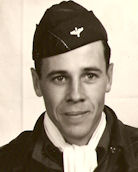Submissions of 303rd Bomb Group related stories and articles are most welcome.



May 15, 2011
Volume III, Issue 5
www.303rdBG.com
– All he wanted to do was to fly –
By John Donnelly,
nephew of 1Lt John J. McGarry
This is a story about 1Lt John J. "Jack" McGarry, Jr., a B-17 pilot assigned to the 303rd Bomb Group, 427th Squadron at Molesworth. I never met my Uncle Jack, but my mother had told me about his life and service in World War II as I was growing up. He and five members of his crew died on Easter Sunday, April 9, 1944 when their plane crashed shortly after takeoff. These were the members of his crew on that day:
|
1Lt John J. McGarry, Jr.; pilot; KIA 2Lt Willie Cotham; co-pilot; KIA 1Lt Robert Halligan; navigator; KIA 1Lt Kenneth Foe; bombardier; KIA T/Sgt Henry Grace; top turret gunner; KIA T/Sgt Stephen Stuphar; radio operator; KIA S/Sgt Ira Friedman; ball turret gunner; WIA S/Sgt Ervin Hilborn; right waist gunner; WIA S/Sgt Michael Vargas; left waist gunner; WIA S/Sgt Walter Kowalonek; tail gunner; WIA |
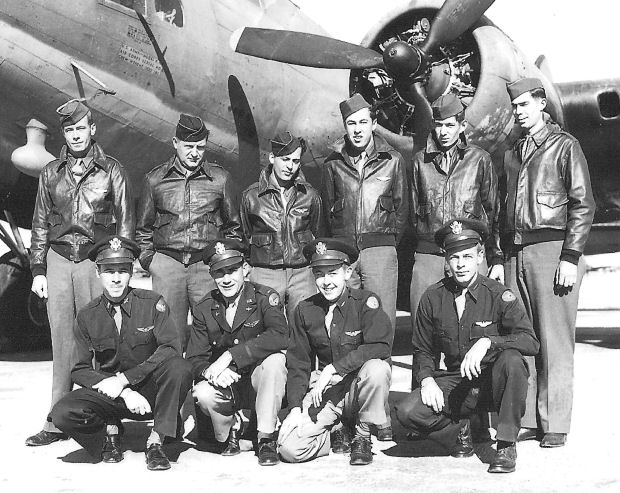
JOHN J. McGARRY CREW - 427th BS
(Back L-R) T/Sgt Henry J. Grace (E), S/Sgt Walter A. Kowalonek (TG), S/Sgt Ira Friedman (BT),
S/Sgt Ervin Hilborn (LWG), Sgt Elmer A. Wilson (R), Sgt Edgar S. Brown (RWG)
(Front L-R) 1Lt John J. McGarry (P), 2Lt Willie C. Cotham (CP),
1Lt Robert W. Halligan (N), 1Lt Kenneth D. Foe (B)
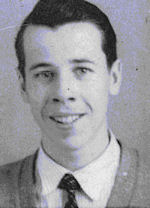 |
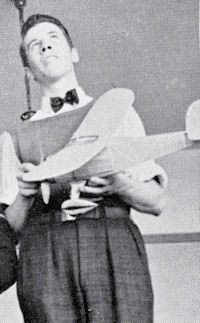 |
In a letter to a friend back home: "I surely wish this was all over and we could be thinking about coming home but there is a long hard job ahead yet and there will probably be no going home for many. I just hope that the people back there realize what everyone is going through for them.…When the flak bursts blacken the sky and the fighters are diving in on you with guns firing you don't have a chance to pray. But if things quiet down for a few minutes I always manage a short prayer."
From another letter: "It seems like ages since I've been home last. Maybe it's because of what I've been through since I've been over here. I hope it won't be too long before I can be home with everyone again."
In his final letter: "Naturally, with my promotion to 1st, came more responsibility. I am alternating now in leading our squadron. My first job in leading was a trip to Big "B", or Berlin. Truly a great honor and a tough assignment…."
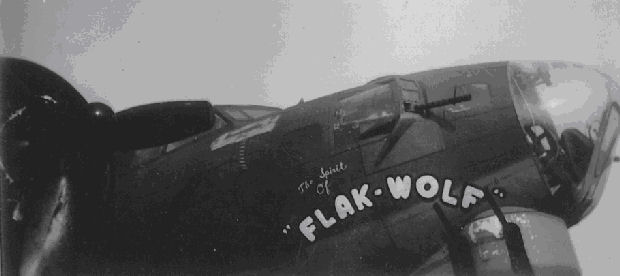
B-17G #42-31616 Spirit of Flak Wolf (427BS) GN-U
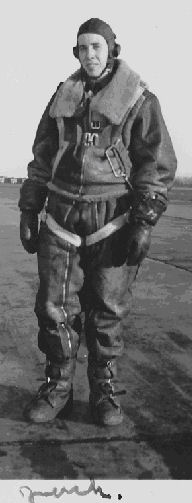 |
In 1999, I was able to speak with Ervin Hilborn (right waist gunner) on the telephone. By his recollection of their 18 completed missions, they landed just four times with all four engines operating. The crewmembers called my uncle "Mac". He was cheerful and they knew he was a good pilot. "Lady Luscious was the first plane we were assigned," Hilborn said. "We got shot up quite bad over Munich and made an emergency landing at an English fighter base. That plane never flew again."
Shortly after this, I received a response by letter from Elmer Wilson (radio operator). "I was hit over France and the pilot headed straight back to Molesworth. I was unconscious from the time I was hit until waking up on the operating table. The doctor asked me if I knew anyone in the room and I said, 'that's my pilot standing over there.' The lieutenant broke down and cried-that showed me he cared for his crew."
 |
In early 2010, I exchanged emails with the editor of The Molesworth Pilot, Gary Moncur. By coincidence, Eric Goodwin had also been in contact with Gary and mentioned that as a teenager, he lived near Molesworth and remembered the crash on Easter Sunday, 1944. Gary then put us in contact with each other and we began exchanging emails.
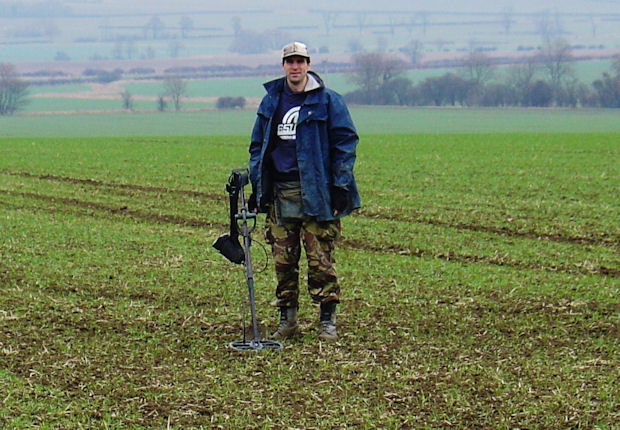
Simon Ashford with his Metal Detector at the crash site.
"I went up to crash site one evening in April (2010) with my dog and walked the length of the field (crash site)," Eric said. "When I arrived back at my car a man was there. His name was Philip Smith. We started talking and he said he and his friend Simon Ashford were going to metal detect the field for Roman settlements. I told him what happened in 1944 and asked him to save any alloy bits for me and a few days later, he sent me (Eric) a photo of a part."
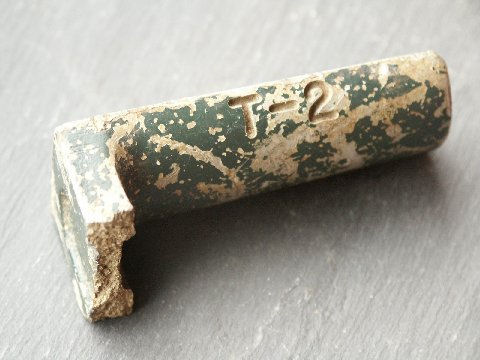
Recovered #2 Engine Throttle Handle from B-17G #42-31616 Spirit of Flak Wolf
Eric continued, "I phoned Chris Hughes of the Intelligence Fusion Centre, Molesworth to see if he could help identify it." Chris also works as a volunteer at the famous Imperial War Museum at Duxford, which is a former WW2 RAF and USAAF air base. "One of my duties used to be 'housekeeping' inside one of our B-17's there," Chris explained. "So having dusted and polished the throttle quadrant, I just knew I'd seen the part before when Eric showed me the photo!" The number 2 throttle handle from The Spirit of Flak-Wolf had been found after 66 years.
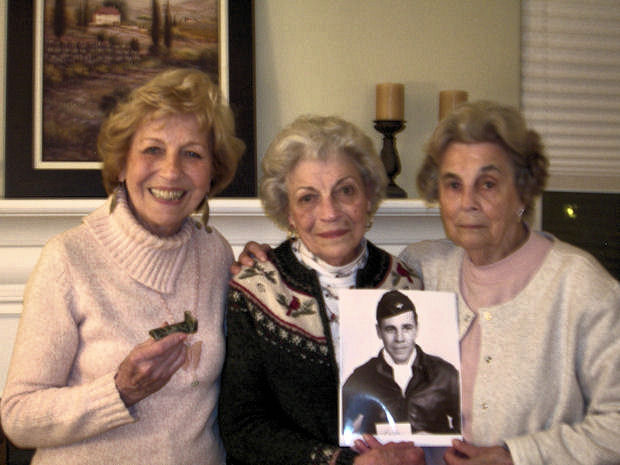
McGarry sisters Barbara, Dorothy, and Madaline with the Throttle Handle
Eric Goodwin graciously sent the throttle to me in Ohio via Royal Mail and a few days later I drove three hours to give it to my mother (Lt McGarry's youngest sister). I explained to her what it was and how it came to be that one of the last things her brother touched was in her hands now. I can say she was deeply touched-a mixture of great sadness and joy. Shortly after this, she shared this treasure with her two sisters.
Our family is very grateful to all the generous people who helped us learn more about a loved family member, 1Lt John J. "Jack" McGarry, Jr. We know he did his duty. He did his best.
![]()
by Buddy Palla, WVPGR Assistant State Captain
Veterans Day 2008
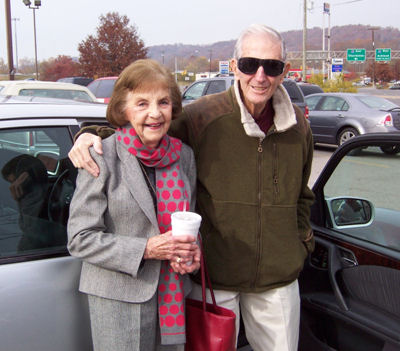 Today, we stood in the presence of greatness, but it was greatness seasoned with humbleness. The Patriot Guard Riders were honored to spend some time with Mr. Abbott Smith, a WWII B-17 crew member, who truly personifies the character, selflessness, honor and integrity of “The Greatest Generation.”
Today, we stood in the presence of greatness, but it was greatness seasoned with humbleness. The Patriot Guard Riders were honored to spend some time with Mr. Abbott Smith, a WWII B-17 crew member, who truly personifies the character, selflessness, honor and integrity of “The Greatest Generation.”
The morning was cold, probably at or below freezing, when many of us left home for this special mission. We were met at Shoney’s in Huntington by Peg Smith, Abbott’s wife. She is a dear lady, and was so happy to see us there to honor her husband. I was curious as to whether or not this was still a surprise for Abbott, and she affirmed it was. We prepared bikes to fly flags, some went to find a cup of something hot to drink, and we met some new friends.
Around 1040, our guest of honor arrived, transported by his good friend (and our mission confidant), Mr. Bill Bunch. Bill is the one who was going to pick Abbott up at his home, and take him to their lunch bunch meeting at the Pullman Plaza Hotel. What Abbott didn’t know, was Bill was in “cahoots” with the PGR. Bill pulled his car into the lot, and parked right in front of the bikes. As he opened the door, he said, “Abbott, these folks are here for you.”, and Abbott replied, “I can’t believe it!” This was a phrase we would hear repeated many times during the morning.
We all began to talk and introduce ourselves to Abbott…his enthusiasm and sheer joy at having us there, put a smile on everyone’s face. The air temperature may have been cool, but there were plenty of warm hearts in Shoney’s parking lot this morning.
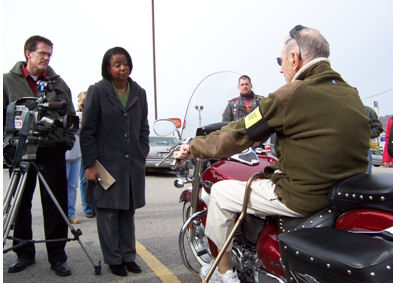 We were pleased to see the WSAZ News Channel 3 crew arrive, and once again, we heard those familiar words from Abbott, “I can’t believe it.” Someone in the group came up with the idea that the interview should take place with Abbott sitting on a motorcycle, and Gary Young’s bike was chosen. Keith Mitchell handed me his PGR armband, and I told Abbott we were making him an honorary member of the Patriot Guard Riders today.
We were pleased to see the WSAZ News Channel 3 crew arrive, and once again, we heard those familiar words from Abbott, “I can’t believe it.” Someone in the group came up with the idea that the interview should take place with Abbott sitting on a motorcycle, and Gary Young’s bike was chosen. Keith Mitchell handed me his PGR armband, and I told Abbott we were making him an honorary member of the Patriot Guard Riders today.
So, with Abbott’s armband in place, and with him positioned on Gary’s bike, the interview began.
Even though we all thought this was Abbott’s day, he made it clear to all of us that it’s about all veterans, including the ones currently serving overseas. His graciousness showed through in his obvious concern for others…what a kind and compassionate gentleman he is!
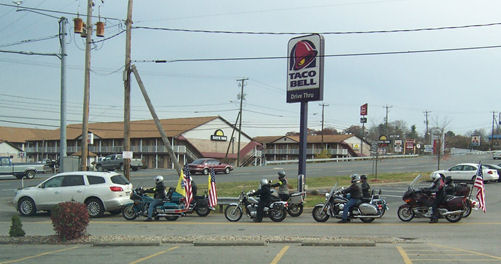
After the interview had been completed, and after everyone had taken the opportunity to shake hands with Abbott, he thanked us for coming. I said, “Abbott, we’re not through, yet. We’re going to give you a motorcycle escort to your lunch location.” Again, we heard, “I can’t believe it!” We formed up the motorcade, and hit the road. The bikes led the way, followed by Bill Bunch and Abbott in Bill’s car, two PGR cages, and Pat Hanifin’s flag-flying truck bringing up the rear. As we rode along Route 60, I frequently heard on-coming vehicles blow a “salute” with their horns, and saw some drivers giving a big thumbs-up to us. I doubt if they knew just how precious the “cargo” was we had been called upon to escort.
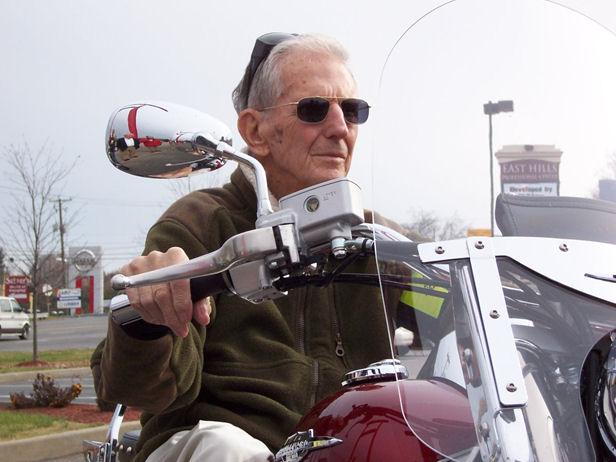
After arriving at the hotel, we went inside to make our final presentations to Abbott, in front of his friends and colleagues. The PGR presented him with a framed picture of his B-17 crew from 1943, a plaque commemorating him as a true American hero, and two challenge coins.
We all know each mission is special, and there’s always something to be remembered from each one. Today, I will remember the look of surprise on a man’s face, I will remember the joy in his eyes, and I will remember how fortunate America is to have men like Abbott Smith. Men like Abbott Smith are a national treasure, and the PGR was honored to be with him today.
Mr. Abbott Smith, you are an American hero…I proudly salute you, Sir!
![]()
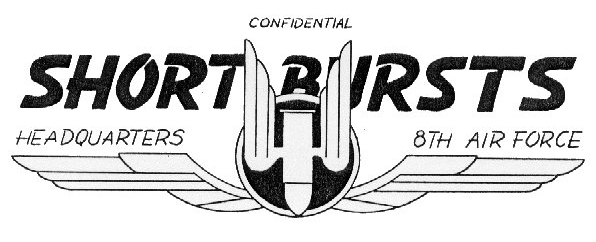
by 2Lt Billy L. Runnels
The following short stories add a bit of color to the more serious 2nd Lt. Billy L. Runnels Report.
Most are amusing and remain an indelible part of my memory after nearly sixty years.
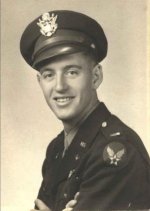 Jefferson Barracks - St. Louis, Missouri
Jefferson Barracks - St. Louis, Missouri
Basic Training took place at Jefferson Barracks. Our troop train from Kansas City, Missouri arrived about midnight on a Saturday. We departed Kansas City at 10:30am and visited most sidings en route to let other trains with higher priorities pass. On arrival a sergeant herded us through a supply depot where we were issued bedding for the night. They got us up bright and early Sunday morning to stand roll call in the company street. A light drizzle was falling at the time. We were standing at attention when the sergeant yelled, "Hey you". I looked to see if he was talking to me and you guessed it. I was assigned the duty of picking up cigarette butts in the Company Street. This was a far cry from my normal routine of attending church.
The food at Butler was prepared by a staff of women and truly took on the appeal of home cooking. It was without question the best food I had in the service. Sunday morning breakfast was especially tasty. The mess hall opened at 6:30am and I made an effort to be as close to the front of the chow line as possible. When the doors opened I rushed in, ate fast, then took the one half mile trek through a wooded area to the chapel. Following service, I ran back and got in line again before it closed at 10:00am. I didn't always make it but I sure gave it a try. Believe me, it was worth the effort.
We had completed several days of intense testing to determine our continued training assignment as pilots, navigators or bombardiers. The results had not been posted. We were at loose ends and didn't have much to do. One morning at roll call they asked for six volunteers and I responded. The six of us were loaded in a truck and taken to a refrigerated storage building. Our assignment was to load between forty-five and fifty hindquarters of beef in a refrigerated truck. Each weighed 60 to 65 pounds but were firm from the cold storage so it was a simple task to throw one over your shoulder and take it to the delivery truck. We completed the loading only to learn that we had to accompany the truck and unload at mess halls at several military bases in the area. It was a hot day and the firmness of the meat softened to a slippery, soft glob which made it hard to handle. It took all six of us to unload the last quarter and we dropped it in the graveled company street. I don't remember ever volunteering again during the remaining time of my tour.
We trained in AT-11 twin engine aircraft. Early one Sunday morning I was assigned to a cross-country navigation hop. These were always a challenge because there weren't many ground checkpoints to refer to. Midland, Texas was in the panhandle and surrounded by level country. About all you could see was sand. The pilot was a 2nd Lieutenant who had partied the night before so he wasn't very happy about his assignment. We took off and had been in the air about fifteen minutes when both engines stopped. I strapped on my parachute and was ready to respond to the bail out bell. Looking through the rudder pedals I witnessed the pilot's frantic efforts to solve the problem. I think he had been sleeping because the aircraft was on autopilot and I was controlling the direction with the bombsight. He put the AT-11 in a dive and got one propeller wind milling fast enough to get it started. He was successful in starting the second engine the same way. We completed the mission without further incident. After landing the pilot said "Cadet, I hope you won't tell anyone about the problem we had". I said I wouldn't and I didn't. A casual friendship ensued. I did inquire as to what happened and he said we took off on wing fuel tanks and he forgot to switch to the main tanks so they ran dry, This proved to be a testy period for both of us.
A weekend in New Orleans, Louisiana was the ticket and we made that short trip at every opportunity. The Roosevelt Hotel became the unofficial Officers Quarters and we were treated royally. The French Quarters were shoulder to shoulder with military personnel. It was a fun city at a fun time. However, I remember mostly the trip back to the base. We were required to sign-in by midnight, Sunday. After doing so I headed directly to the officers mess hall. Scrambled eggs, bacon, hash browns, toast, coffee and a sweet roll never tasted better.
 Our crew had maintained a great training record so we were cleared for a cross-country trip to Montgomery, Alabama on a day when the weather was questionable. We were contacted en route and ordered to return to base immediately as the weather was deteriorating rapidly. The landing approach from the north brought us in east of New Orleans over the Bay of St. Louis. From there we would follow the Gulf coastline east to the air base at Gulfport. The broken layer of clouds were very low but the water and ground were still visible. The navigator and I closed shop and moved to the radio room for landing. However, the landing didn't take place.
Our crew had maintained a great training record so we were cleared for a cross-country trip to Montgomery, Alabama on a day when the weather was questionable. We were contacted en route and ordered to return to base immediately as the weather was deteriorating rapidly. The landing approach from the north brought us in east of New Orleans over the Bay of St. Louis. From there we would follow the Gulf coastline east to the air base at Gulfport. The broken layer of clouds were very low but the water and ground were still visible. The navigator and I closed shop and moved to the radio room for landing. However, the landing didn't take place.
After a lengthy period of time had passed, I went to the flight deck to find out what was going on. By this time darkness had set in. The pilot had tried a radio beam let down but the beam split and it didn't work. The two guys on the flight deck had argued about the procedure and weren't talking to each other. It didn't take me long to break the silence. We were lost and had been for over an hour.
The navigator and I returned to the nose and with radio fixes determined our general position. We took up a heading for New Orleans and the city lights piercing the solid lower cloud layer were a welcome site. We flew the coast light line to the base and made a routine landing. The B-17 had just stopped rolling on the runway when a jeep pulled up and took the pilot and navigator to operation headquarters for a briefing. I guess they caught hell. A three-state search alert for a possible downed aircraft had been initiated.
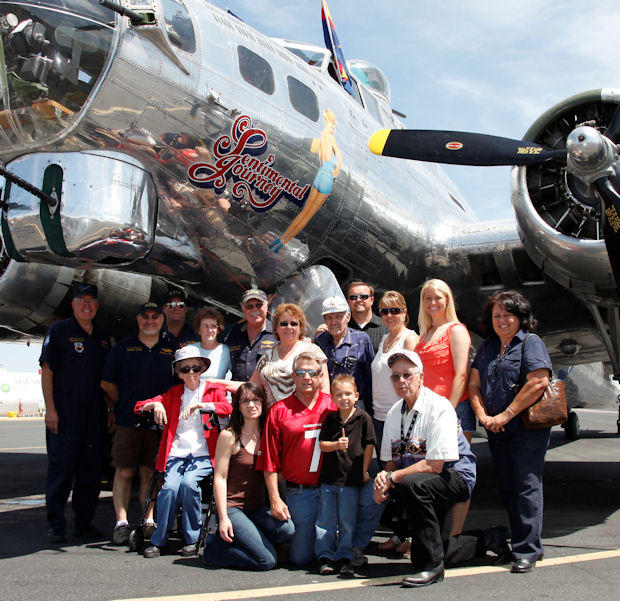
After the flight, the family posed with the flight crew (in the dark blue shirts). The Roth family members are (Back L-R) Judy Sunderlin, Linda M. Roth, Charles L. Roth, Charles R. Roth, Christine Roth, CJ Norvell and Molly, a family friend. (Front) Mrs. Charles L. "Donna" Roth, Bettina M. Roth, Charles I. Roth, Charles A. Roth) and Bill Sunderlin.
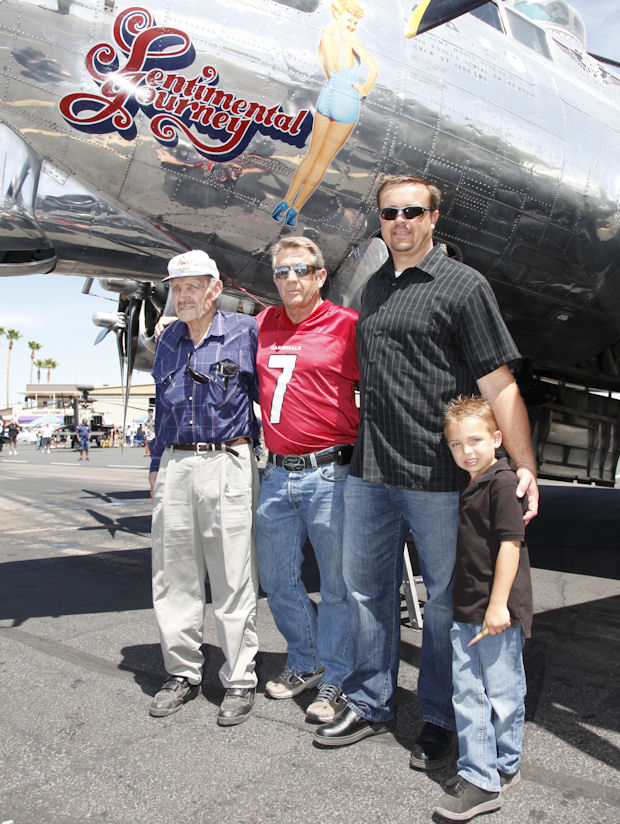
Chuck, Chuck, Chuck and Chuckie!
Four generations of father and son:
Charles L. Roth, Charles I. Roth, Charles R. Roth and Charles A. Roth
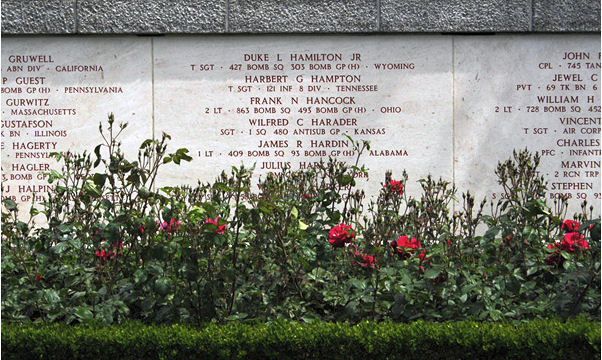
We Shall Never Forget
Remember Our Veterans on Memorial Day: May 30, 2011
Wall of Missing at Brittany American Cemetery and Memorial, St. James, France
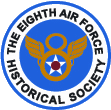
 8th AIR FORCE HISTORICAL SOCIETY
8th AIR FORCE HISTORICAL SOCIETYANNUAL REUNION
SHERATON WESTPORT – LAKESIDE CHALET
ST. LOUIS, MO – OCTOBER 11 – 16, 2011
Reunion and registration information are now available. See:
http://www.8thafhs.org/reunions.htm
Now Available !!
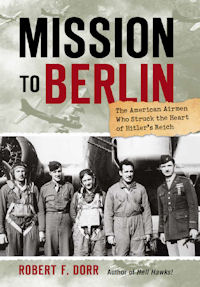 The book "MISSION TO BERLIN" by Robert F. Dorr was published April 15. This is a general-interest World War II history that focuses on the B-17 Flying Fortress crews who attacked Berlin on February 3, 1945, in the largest mission ever flown against a single target. The book also includes a new look at the entire bombing campaign in Europe.
The book "MISSION TO BERLIN" by Robert F. Dorr was published April 15. This is a general-interest World War II history that focuses on the B-17 Flying Fortress crews who attacked Berlin on February 3, 1945, in the largest mission ever flown against a single target. The book also includes a new look at the entire bombing campaign in Europe.
The young men who flew and maintained the B-17 are at the center of the story but "MISSION TO BERLIN" also has lengthy passages about Americans who flew and maintained the B-24 Liberator, P-47 Thunderbolt and P-51 Mustang.
Bob Dorr is technical editor and co-creator of this journal and was recently honored by the Foundation for his work on Air Power History. Bob describes "MISSION TO BERLIN" as a "Stephen Ambrose-style popular history of the triumphs and tragedies of everyday Americans who did something no one had done before. They fought giant battles several miles up in the sky across vast distances inside aircraft where oxygen was always needed and the temperature was almost always below freezing."
"MISSION TO BERLIN" is available from on-line sources and at bookstores. You can order a signed copy directly from the author by contacting Robert F. Dorr, tel. (703) 264-8950, robert.f.dorr@cox.net
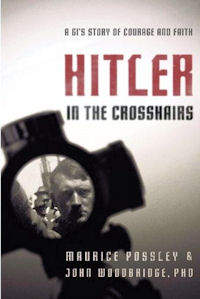 Hitler in the Crosshairs:
Hitler in the Crosshairs:
A GI's Story of Courage and Faith
by Maurice Possley and John Woodbridge
A Pulitzer Prize-winning journalist teams up with a university scholar in this compelling, untold historical tale of a young man's courage at a critical time in United States history, and the saga of a dictator's pistol that continues today.
The time is World War II. Young soldier Ira 'Teen' Palm and his men burst into a Munich apartment, hoping to capture Adolph Hitler. Instead, they find an empty apartment ... and a golden gun. As the authors trace the story of the man and the gun, they examine a time and place that shaped men like Palm and transformed them into heroes. They also follow the strange journey of Hitler's pistol.
The book also tells the story of 1Lt Bernard T. McNamara, navigator on the 358th BS 1Lt John W. Hendry Crew — how he was shot down, escaped from a Nazi prison camp, and went on to play an integral role in a revolt against the Nazis in Munich by German troops and German citizens.
![]()
 Winston Earle Boutelle, LT. COL., USAF (Ret), 90, passed away peacefully on April 24, 2011 at Air Force Village West, Riverside, CA. Born in Bristol, CT on September 16, 1920.
Winston Earle Boutelle, LT. COL., USAF (Ret), 90, passed away peacefully on April 24, 2011 at Air Force Village West, Riverside, CA. Born in Bristol, CT on September 16, 1920.
He enlisted in the U.S. Army prior to WWII and then served in the Army Air Corps during WWII. Lt. Col. Boutelle served as a B-17 bombardier with the 8th Air Force, 303rd Bomb Group, 359th Squadron, and flew 25 missions over Germany. He was awarded the Distinguished Flying Cross and the Air Medal with four Oak Leaf Clusters.
After retiring from the Air Force in 1963, Lt. Col Boutelle served as a regional sales manager for United Services Life Insurance Co. for 22 years in Rapid City, SD. His two great loves were his wife, Sally, and the game of golf, which he began playing as a boy. He is survived by loving wife Sara (Sally) Boutelle, son Ronald Boutelle and wife Kay, son Kevin Boutelle and wife Jamie, daughter Lisa Boutelle Lazzara, brother Gordon Boutelle and wife Marion, brother Donald Boutelle and wife Loretta, grandchildren Ian Boutelle and Melinda Boutelle and three great-grandchildren. He was preceded in death by his parents Harold and Ruth Boutelle and son Larry Boutelle. A private service is planned. In lieu of flowers, donations may be made to the Air Force Village West Foundation or to the American Cancer Society .
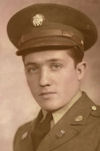
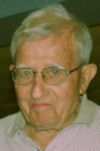 Martin Marshall Harbarger (93) MSGT USAF-RET, died April 28, 2011. Born in Uniontown, PA (1917) formerly of Fairborn, OH and most recently of Bradenton, FL, beloved husband of 66 years of Betty J (nee Devan); loving father of David (Ellen) of Lakewood, Ohio, Margaret Nervo of Akron, Ohio, Patricia LaBarr (James) of Bradenton, FL, Brenda Waldrop (Michael) of Yelm, WA, and Beth Layman (John), of Indian Harbour Beach, FL; grandfather of 11 and great grandfather of 10; survived by 4 of 12 siblings, Floyd, Franklin, Anna Catherine and Tillie.
Martin Marshall Harbarger (93) MSGT USAF-RET, died April 28, 2011. Born in Uniontown, PA (1917) formerly of Fairborn, OH and most recently of Bradenton, FL, beloved husband of 66 years of Betty J (nee Devan); loving father of David (Ellen) of Lakewood, Ohio, Margaret Nervo of Akron, Ohio, Patricia LaBarr (James) of Bradenton, FL, Brenda Waldrop (Michael) of Yelm, WA, and Beth Layman (John), of Indian Harbour Beach, FL; grandfather of 11 and great grandfather of 10; survived by 4 of 12 siblings, Floyd, Franklin, Anna Catherine and Tillie.
Served with the 8th Air Force, 303rd Bomb Group (B-17), "Hell's Angels," US Army Air Corps out of Molesworth England during WW II; shot down in a raid over Wiesbaden, Germany on August 15, 1944; captured by German troops and held as POW in Stalag Luft IV; endured forced POW Death March from late February 1945 until liberation by US Troops of the 3rd Army at the end of April 1945; awarded the Purple Heart for wounds in combat, the Air Medal and other decorations; after WW II served in Tactical Air Command and Strategic Air Command until retirement from Active Duty in 1962.
Funeral Services Wednesday, May 4, at 11:00 at Brown & Sons, 5624 26th St W, Bradenton; burial at Sarasota National Cemetery with full Miliary Honors at 2 PM May 4. The family suggests donations to the 8th Air Force Museum Association, P.O. Box 75, Barksdale AFB, La. 71110, or The National WWII Museum, P.O. Box 97336, Washington DC, 20090, in lieu of flowers.
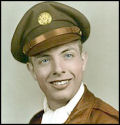
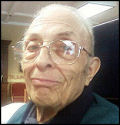 Donald Francis Geng, age 87, A loving and gentle man of deep faith Don peacefully "slipped the surly bonds of Earth" April 26, 2011.
Donald Francis Geng, age 87, A loving and gentle man of deep faith Don peacefully "slipped the surly bonds of Earth" April 26, 2011.
A life-long resident of St. Paul, Don was born to Francis J. and Martha (Illa) Geng on April 14, 1924. Don acquired his life-long fascination with all things aeronautical at an early age from his father. Don grew up at Holman Field, where he assisted mechanics and pilots alike and was repaid with flying lessons, earning his pilot's license at age 14. After graduating from Monroe High School in 1942, where he received the American Legion's Outstanding Student Award, Don enrolled at the U of M where he planned to study aeronautical engineering.
Don enlisted in the U.S. Army Air Corps in 1943. Following basic training and gunnery school, Don was assigned to the 303rd Heavy Bombardment Group at Molesworth, England where he joined the crew of a B-17 Flying Fortress as a ball turret gunner in December 1944. On his 13th mission on February 9, 1945, his plane sustained flack damage after releasing its bombs and a Luftwaffe fighter squadron inflicted further damage. The pilot ordered the crew to bail out. Don was captured after parachuting into a German farm field; he spent the remainder of the war as a POW.
After the war, Don returned to the U where he graduated with a B.S. in Mechanical Engineering from the IT in 1948. Don spent his professional career as an engineer with several architectural firms before joining the Metropolitan Waste Control Commission as a Staff Engineer from 1975-1995.
The focus of Don's life, however, was his family, his children's education, and his church. Don's life-long friend, Bob Barry, introduced him to Bob's cousin, Patricia Elaine Barry, the love of his life. They married at Holy Spirit in June 1950, and raised five children in the parishes of Holy Spirit, St. Pascal's and Nativity. Don was a particularly active member of Nativity Church and School, where he long served as a lector, cantor and Eucharistic minister as well as a member of the Choir and the Men's Club. He actively supported his children's high schools at Our Lady of Peace, Cretin, and Derham Hall.
Following his beloved Pat's death in 1989 and his retirement in 1995, Don actively pursued his aviation interests, serving as a guide and historical interpreter at the Air Guard Aviation Museum; the Planes of Fame Museum; numerous air shows throughout the Twin Cities; attending annual reunions of the 303rd Bomb Group; serving as an Officer of the 8th Air Force Historical Society; and spending countless hours with a small group of aviation friends who built a 1918 Curtiss JN4 "Jenny" airplane from scratch. That plane now hangs in the rotunda of the Minnesota History Center. Don was a long-time member of Hamline American Legion Post 418, and an enthusiastic supporter of Attucks Brooks American Legion Post 606.
Don is now reunited with his loving wife Pat, parents Frank and Martha, stepmother Ethel (Merrick) Geng, sister Dorothy Necas, brothers Paul and Larry, and two grandchildren, Michael Pringle and Sarah Geng. Don is survived and will be lovingly remembered by his sisters, Elizabeth Joan Glaser of White Bear Lake, MaDonna Jean McCollum of Brighton, Colorado, Catherine (Dick) Treichel of Stillwater, Bea Geng, and Kay Barry Janisch; five children, Jeanne (Mark) Pringle, Don Geng, Elizabeth Kringle, Tom (Nancy Ferrell) Geng, and Kate Jonas, and eleven grandchildren and seven great-grandchildren.
Heartfelt thanks go to Don's Wellesley Avenue neighbors for their kind care and genuine concern for his welfare, especially during his last few years in his home. In lieu of flowers, memorials preferred to Medical Behavioral Services at Bethesda Hospital, St. Paul; Camp Courage; Cretin-Derham; Disabled American Veterans; or Nativity Grade School. Don's family and friends will share memories at O'Halloran & Murphy's from 4:00 to 8:00 p.m. on Sunday, May 1, to celebrate Don's faith and resurrection at a Mass of Christian Burial at Nativity of Our Lord Church at 10 AM on Tuesday, May 3, and to bid farewell to Don at Fort Snelling National Cemetery at 1:30 PM.
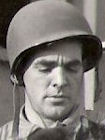
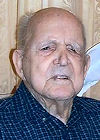 Hector G. Homoleski, 95, longtime resident of Brookline, NH, died April 10, 2011 in Manchester, NH.
He was born in Pepperell, MA on March 6, 1916, a son of John MacIsaac and Ethel (Melendy) Homoleski.
Hector G. Homoleski, 95, longtime resident of Brookline, NH, died April 10, 2011 in Manchester, NH.
He was born in Pepperell, MA on March 6, 1916, a son of John MacIsaac and Ethel (Melendy) Homoleski.
Mr. Homoleski resided in Brookline for most of his life. For 41 years, he was self-employed as a carpenter and specialized in remodeling projects. He was a member of the Ricciardi Hartshorn Post #23 American Legion, Harley Sanford Post #4368 VFW, Benevolent Lodge #7 F.&A.M., Milford and the Brookline Church of Christ.
Mr. Homoleski was a U.S. Air Force veteran having served during World War II.
Family members include his wife, Stella K. (Miller) Homoleski of Manchester, NH; a son, Robert G. Homoleski of Fairbanks, Alaska; two grandchildren, Kathleen Homoleski and Ella Homoleski, both of Fairbanks, Alaska; a sister, Laura Stimson of Keene, NH; a brother, Stephen Homoleski of Milford, NH; many nieces and nephews.
There are no visiting hours. A graveside service will be held on Saturday, April 30th at 2:30 pm in Lakeside Cemetery, Mason Road, Brookline, NH. In lieu of flowers, donations in his memory may be made to Brookline Ambulance Association, 3 Post Office Drive, Brookline, NH 03033.
Sidney "Pete" Underdown COL, 85, of Cherokee Place, Lenoir, died Saturday, July 31, 2004, at his residence.
He was born Jan. 17, 1919, in Caldwell County, to the late Julius V. and Rose Griffin Underdown.
In addition to his parents, he was preceded in death by a brother, and a sister, Ruth Underdown.
Mr. Underdown joined the National Guard when he was a senior in high school in Lenoir, and his unit was mobilized on Sept. 16, 1940. He later transferred to the Army Air Corp and began aviation cadet training, where he became a B-17 pilot. He flew 41 missions in 7 1/2 months. He left the Air Force in 1947 and later transferred from the Air Corp Reserves to the National Guard. He was placed on active duty during the Korean War and retired in 1976 as director of Reserve Components at Fort Meade, Md.
He was employed with Hickory Springs Mfg. as a superintendent. He graduated from Lenoir-Rhyne College and received his master's degree in business from Appalachian State University. He was an instructor at Lenoir-Rhyne College in accounting, taught high school and was an assistant principal at Collettsville Elementary School. Mr. Underdown was assistant superintendent of Caldwell County Schools. He was at the Pentagon as liaison to the Secretary of Defense for the National Guard.
Survivors include his wife of 61 years, Mildred Robbins Underdown of the home; a brother, Kenneth Underdown of Lenoir; a sister, Mrs. Catherine Noel of Fort Meyers, Fla.; and a brother and sister-in-law, Casey and Olivene Robbins of Hickory. Interment in Blue Ridge Memorial Park.
![]()
Dear Mr. Moncur,Keeping the Legacy Alive,My name is Ryan Bartholomew. I am the President of the Malin (Oregon) Historical Society and the Wing Historian for the 173 FW, Klamath Falls OR. Our historical society has received a number of artifacts from the Ehle Reber family (Purple Heart, Air Medal, bible, etc.) Among the items we have received are a couple of scrapbooks. Of the hundreds of scrapbooks I have looked at, I have never seen one more thorough than these. One scrapbook contains all his letters home, all his diplomas from grammar school to flight training at Luke Field. Below is a transcribed letter I found in the scrapbook, written by Mrs. Hamilton to the Reber family. Apparently, Duke Hamilton Sr., father of a Jerry Jinx crewman, went to visit Molesworth shortly after the plane was lost. He talked to Gene Smith, an eyewitness to the loss of the Jerry Jinx. It must have been in February or early March of 1943, because Gene Smith died shortly thereafter when his chute did not open after a mid-air collision. I have sent this letter to Mrs. Henry and she suggested I send it to you. If you would like any specific information about Ehle Reber, just let me know.
The Last Raid January 23, 1943
As told by Gene Smith (eyewitness) to Duke Hamilton Sr. (father of crewman)"It was the largest number of planes ever sent out on a raid up to that time. 60 planes-Fortresses-B-17s. They had had a successful day and had only lost one plane and that was somewhere over France. They were returning to their base and were half way across the English Channel which is 40 miles wide at that place. The 60 bombers were flying in two sections, 30 planes in front, 30 planes in back. All in formation German fighters were after them. The Jerry Jinx was in the rear section and near the end of the formation, may have been the very last plane and Smitty's plane was in the same section but up ahead several planes.
Smitty said up to that time the crew of the Jerry Jinx had been very lucky not ever having had so much as a scratch and their plane had been shot up several times. He said Duke had two German planes to his credit officially, however, he said they all knew he had several more than that, but you can't claim them unless you see them crash. It was 3 O'clock in the afternoon one engine was already dead on the Jerry Jinx having been shot up earlier in the day in a battle over France and more German fighters attacked them as they started to cross the Channel. He said our boys were putting up a good fight and would have won out if the Germans hadn't got another of their engines.
Smitty said several times "if only the English Spitfires had been one minute earlier, Duke would be with me here today." Because they would have chased the German fighters off. However, he said, it really was the fault of the bombers as they were two minutes ahead of time. At such terrific speed a split second means much, anyhow the Spitfires came too late and with the loss of another engine the plane began falling back out of formation and gradually losing altitude. They were flying at 10,000 ft. Naturally when the Germans got one plane crippled then all pounced on it. Smitty was operating top turret guns on his plane (same as Duke on the Jerry Jinx) and said he could see everything. So he called to his pilot on the phone and said "Reber is having trouble, can't you slow down?" His pilot answered -No, we are not allowed to get out of formation for any reason. He told Smitty the Spitfires would be there in a minute and they would take care of them. Then suddenly Smitty said he saw nine boys bail out, just all at once. He said never let anyone tell you the Germans machine gun men parachuting down; they never do. So he figured the tenth man still in the plane was the pilot Reber and he was planning on landing the plane on the water in order to release life rafts but just before too late to jump, the last man bailed out- said he could never figure it out unless he was afraid the plane would go out of control.
Anyways, he saw all ten men bail out and saw all ten chutes open. And that is the last that has ever been heard or seen of any of that crew.
Every day they waited expecting to hear from them. He did admit there could be a chance that they were in hiding somewhere or prisoners. He said they radioed broadcast so it could be picked up by the enemy also of their fate, the location and all. Smitty said the boys knocked down some of the German fighters, and that is why he can't give up. I believe the Germans would pick up their own men, and ours at the same time, but he said the boys could not live long in the icy waters. He said one to two and a half hours. Duke Sr. said the boys differed on opinion about that. Smitty said all had life preservers which would inflate upon hitting the water and would keep them up about an hour. After that they could blow into a tube on their collars to keep preservers filled. Smitty is only 22 years old but looked all of 35 and was getting gray along edges of his hair."
Thank you for all that you do for the 303rd.
Capt. Ryan Bartholomew
Gary,
Again I want to Thank You for highlighting my Father's Story. Your Newsletter and Website are an Honorable and Awesome way to Celebrate the Sacrifices of our World War II Heros!
I am so grateful that I found your website after Dad died and that you were eager to share Dad's Story with your readers. It was such a great loss when he passed and this brings All of us Great Comfort to know that He will be remembered!
Thank you
Beth Stadsvold on behalf Of The Sebastian Vogel FamilyGary:
Thx for great escape true story. Never dawned on me that they'd be sworn to secrecy about what happened to get home. My continuing compliments to you on the marvelous job you do --all the time--on your/our Newsletter.
Frank Boyle
Whitlock's original crew--Gary,
Fascinating memoir by Sebastian Vogel. His name appears a number of times in the Hell's Angels Newsletter over the years, but only as bits and pieces. Never an in-depth account of his evasion. If you drew it out of him, good work. Looks like neither Hal nor I recognized the potential.
Eddie Deerfield (former Hell's Angels Newsletter Editor)

|
